View current page
...more recent posts
MRiver's "CYA" end of the year recap is here. I greatly appreciate the mention of my artMovingProjects show in the Nerdz Rising '06 category. End of the year selections by Rick Silva and bloggy are also published on the MTAA blog.

Ken Lum - Steve - The best repro I could find on Google Images, enlarged in html. Lum took pictures of "normal" people and made deluxe graphics for them so they could be bigger than life, "special." "Steve" haunts me, I don't know why.
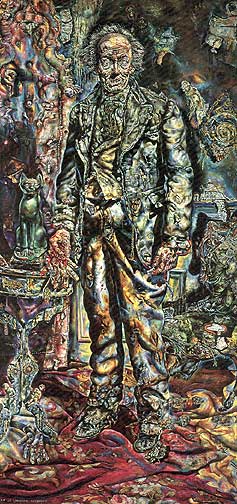
Portrait used in the film The Picture of Dorian Gray, painted by Chicago imagist/outsider Ivan Albright. The 1945 film is tres creepy. One thing it avoids is what exactly Dorian is doing to destroy the young men of society. Wikipedia opines:
The name "Dorian" has connotations of the Dorians, an ancient Hellenic tribe. Robert Mighall suggests that this could be Wilde hinting at a connection to "Greek love", a euphemism for the homoeroticism that was accepted as everyday in ancient Greece. Indeed, Dorian is described using the semantic field of the Greek Gods, being likened to Adonis, a person who looks as if "he were made of ivory and rose-leaves." However, Wilde does not mention any homosexual acts explicitly, and descriptions of Dorian's "sins" are often vague, although there does appear to be an element of homoeroticism in the competition between Lord Henry and Basil, both of whom compete for Dorian's attention. Both of them make comments about Dorian in praise of his good looks and youthful demeanour, Basil going as far to say that "as long as I live, the personality of Dorian Gray will dominate me." However, whilst Basil is shunned, Dorian wishes to emulate Lord Henry, which in turn rouses Lord Henry from his "characteristic languor to a desire to influence Dorian, a process that is itself a sublimated expression of homosexuality."Yet one of the first people annihilated in the film is Angela Lansbury, who Dorian courts and then abandons. So I think we can assume he's bi. The actor who plays Dorian, Hurd Hatfield, is quite the icy mannikin, which adds to the weirdness.
The later corruption of Dorian seems to make what was once a boyish charm become a destructive influence. Basil asks why Dorian's "friendship is so fatal to young men", commenting upon the "shame and sorrow" that the father of one of the disgraced boys displays. Dorian only destroys these men when he becomes "intimate" with them, suggesting that the friendships between Dorian and the men in question become more than simply Platonic. The shame associated with these relationships is bipartite: the families of the boys are upset that their sons may have indulged in a homosexual relationship with Dorian Gray, and also feel shame that they have now lost their place in society, their names having been sullied; their loss of status is encapsulated in Basil's questioning of Dorian: speaking of the Duke of Perth, a disgraced friend of Dorian's, he asks "what gentleman would associate with him?"
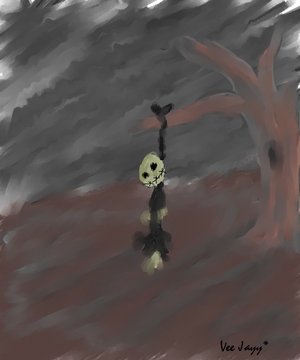
me see Saddam on teevee
he bad man
George Bush good man
kill Saddam dead
everybody happy now
--a typical American
(image from deviantart.com)
Jim Henley:
...the US and its Iraqi allies chose to try Saddam on one of his relatively minor crimes because if they did so they could get him safely hung before they had to try him for the major ones, the gas attacks and massacres that happened during The Years of Playing Footsie with the United States. The Dujail reprisals were a war crime, no doubt about it, a bigger sham of justice than Saddam’s own trial, by two orders of magnitude. They were also the sort of war crime that people like Ralph Peters and a hundred other pundits and parapundits think the United States should be committing. Every time you read a complaint about “politically correct rules of engagement” you are reading someone who would applaud a Dujail-level slaughter if only we were to perpetrate it. Those are the people who are happiest of all about tonight’s execution. Smells like - victory! It’s the pomander they don against the stench.Juan Cole, writing for Salon:
Saddam Hussein was tried under the shadow of a foreign military occupation, by a government full of his personal enemies. The first judge, an ethnic Kurd, resigned because of government interference in the trial; the judge who took his place was also Kurdish and had grievances against the accused. Three of Saddam's defense lawyers were shot down in cold blood. The surviving members of his defense team went on strike to protest the lack of protection afforded them. The court then appointed new lawyers who had no expertise in international law. Most of the witnesses against Saddam gave hearsay evidence. The trial ground slowly but certainly toward the inevitable death verdict.New York Times headline writer: "Saddam Hussein never bowed his head, until his neck snapped." Oh, man, you should be, like, a writer. That makes me feel like, I don't know.
Financial Times:
One of the witnesses, Judge Munir Haddad, was quoted by CNN as saying that as the noose was being tightened around Mr Hussein’s neck, one of the hangmen shouted out "Long live Moqtada al-Sadr." "Moqtada al-Sadr," said Mr Hussein mockingly [...] According to the report, those were Mr Hussein’s last words.Glenn Greenwald:
It really is striking, and a potent sign of just how absurd is our ongoing occupation, that the "Iraqi Government" which we are fighting to empower could not even conduct this execution with a pretense of legality or concern for civilized norms -- the executioners were not wearing uniforms but leather jackets and murderers' masks, conducting themselves not as disciplined law enforcement officers but as what they are (death squad members and sectarian street thugs). [...] But as Floyd also correctly observes, Saddam was in U.S. custody until the very last minute, and both the fact and the terms of the execution required the approval of Bush officials, which they gave -- implicitly, if not explicitly, by handing over Saddam for his middle-of-the-night noose fitting. Comparisons to the relatively dignified and orderly Nuremburg executions only serve to highlight how far America has tumbled under this administration, on every level that matters.



Artist and Bodenstandig 2000 musician drx (Dragan Espenschied) has stepped up to the plate and showed us his gnomes.
I think if the uptown Abstract Expressionist who was hiding his gnomes had done ones this good his dealer wouldn't be screaming but thinking of ways to reinvent him as an artist in the Peter Saul/Basil Wolverton school.
Beautiful-sounding, twisted logic from the antiwar sister of an American in Iraq:
Victory being out of the question at this point, the only democracy my brother is fighting for in Iraq is our democracy. The only constitution he is in Iraq fighting to defend is our Constitution. If my brother dies, it will not be for a mistake but rather because of his deeply held belief that the time it takes us as a people to figure out through democratic processes that we are wrong is more important than his own life.Great, lovely, but what about all the Iraqis he's helping to kill while we democratic idiots figure out what we did wrong? The essay in the Washington Post where this paragraph comes from is just comforting sophistry from someone stuck between the rock of her convictions and the hard place of her brother's participation in a war that has needlessly slaughtered people who never threatened the US. She's ultimately enabling his bad choices (or our leaders') with this desperate argument.
"Massively Huge" [mp3 removed]
Happy and e-piano-y tune for the holidays. The back story is I found this bunch of samples buried inside a Reaktor "groovebox" called Massive. (Not to be confused with Massive the synth, also from Native Instruments--but of course they will be.) The samples are supposed to be raw material for further slicing and granular weirdness in the beatbox context. I find that kind of music to be mushy, arty and same-y but I really liked the samples by themselves. So I moved them into a sampler and gave them pitches and wrote simple tunes for them. The piece has a kind of kitchen sink feel, with house music piano chords rubbing up against mangled electronic percussion stabs, but it moves along. The drum tracks are 3 different machines playing at once, two hardware and one soft.
(Similarities to London Elektricity are happily acknowledged, although breakbeats are hardly used.)

Headphones 2, a ceramic piece from my student days.
The New York police department now has a cable-car-like boxes for elevated surveillance, raised and lowered on extensible arms like fireman's ladders. They make appearances whereever crimes might occur--most recently that danger zone Times Square. Officially they're called Sky Watch; Curbed calls them the Towers of Fun. Portable prison camp turrets gets my vote. In a pinch they could probably be outfitted with those new microwave "crowd control" weapons, to complete the degradation of the citizenry. Police state, we're on it.
"Two Note Lead" [mp3 removed]
An exercise in musical minimalism using the Electribe RmkII, an instrument I've been neglecting as I learned my way around the Vermona analog drum machine. The Electribe, being an analog-modeling digital synth, has a more brittle, metallic sound, but that's not without its pleasures. I only used the machine's onboard sequencer for the "break" or second theme in the middle--everything else was performed in my computer's host sequencer, which plays the Electribe via MIDI. The played and internally sequenced parts were then sampled and overlayed inside the host; you can hear some phasing and detuning when two like parts are played simultaneously and crossfaded. The most time was spent on changing the settings of the Electribe's rhythm synthesizer voices, away from some fairly awful presets. The resulting piece has an "Assault on Precinct 13" feel--if I can be so presumptuous--but clangy and jangly (and more upbeat than the Carpenter).
Update: snipped out four bars in the middle.
"Entropic Funk" [mp3 removed]
A sequence I wrote is played with four Sidstation patches--Sharp Interval Lead, PWM1, Subloop, and Moonmachine (the last is the crunchy, high pitched one)--all run through the Mutator filter using a gate setting to shorten the envelope. These segments are recorded into the sequencer one at a time and overlapped with each other to create a kind of round and/or counterpoint. Also in the musical staff is a marimba sequence using the same notes phased and "fattened" in a sampler, and a drum pattern that comes and goes. As the title suggests, the piece starts off energetic and urban and gets more Subotnick-abstract but without losing the spine of a perky melody.
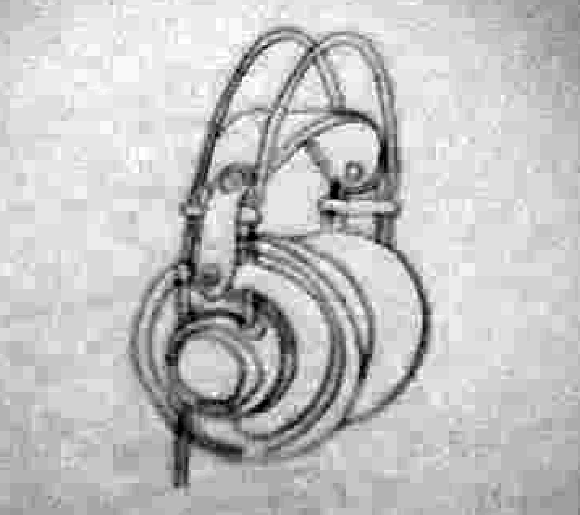
Headphone drawing by Marisa Olson - my remix.
The following exchange appeared in Houston's online magazine GlassTire back in 2001:
Tire Iron #6 3/15/2001
Inman Gallery
by Bill Davenport
I confess: I myself show at Inman Gallery, so if you feel that this invalidates my opinion of other work shown there, you can stop reading now.
John Pomara's glossy enameled panels are competent, affectless, impersonal. In the past I have used the phrase "toxic pond sludge" (I meant that in a good way) to describe Pomara's abstractions, but these new works at Inman gallery are cleaner. The panels are either black or white; the black ones suggesting nighttime landscapes, time-lapse photographs of headlights on a rain-slick city street. The proportions of the white panels suggest sheets of milky paper, squeegeed into horizontal zips like writing.
In both cases, the vertical orientation of the panel counteracts the horizontal stretch of the painting. Compare these works to Barnet Newman's: if Newman's vertical zips are the figure reduced to its essential gravity-defying assertion of existence, Pomara's horizontal streaks are the equivalent distillation of landscape, stretching flat and sliding sideways at high speed.
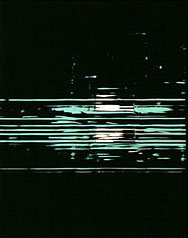
John Pomara, Pipeline, 2000
oil enamel on aluminum, 30 x 24 inches
Although they are emphatically about the glossy deliciousness of industrial paint, Pomara's works don't feel like paintings. Their exposed edges show that each is a thin sheet of aluminum laminated to birch plywood. The panels seem manufactured, not painted: the result of the impersonal operation of chance and technique.
The odd, syncopated hanging of the show does a lot for the work; irregular intervals between the panels make them into a sort of Morse code: intermittent, static-laden signals on the information superhighway. In the entranceway, a large black panel is hung next to a similar small one, upsetting one's expectations of typical gallery-style installation. The two panels have an odd relationship: a large and small version of the same thing, or possibly one close-up and one far away.
A discussion of Pomara's work is incomplete without referencing the very similar works of Houston artist Tad Griffin, Pomara's former student. Their co-existence is an opportunity to make subtle comparisons that highlight nuances of both artists' works, which are usually submerged. Here we are comparing, not pears and oranges, but Bosc vs. Bartlett. Both Griffin and Pomara swipe intermittent stripes of black and white paint across aluminum panels. Pomara's recent works are more pictorial: his streaks condense at the middle of the panel to imply depth, demarcating foreground, middle, and background; Griffin's all-over patterns are a depthless skin stretched across the surface of his paintings. Griffin's intervals are regular, but not mechanical; he is a man imitating a machine. Pomara's irregular compositions of stripes and gaps are the opposite: a painter using mechanical techniques to depersonalize his pictures. If we can collect one or two more Texas squeegee painters we'd have a school!
Response to Tire Iron #6 3/15/2001 [Update: this comment has gone missing from Glasstire but I saved it here]
Bill Davenport makes some good points about John Pomara's work. I have a couple of quibbles, and a thing or two to add. First, when I read that something is "competent, affectless, and impersonal," my first question is, why? I wish Davenport had gone more into the reasons a painter might deliberately work that way. My own theory is that many painters are still drawn to "the gesture," an unplanned, frequently exhilirating way of generating visual information, but are sick of the romantic action-painter myth left over from the '50s. The use of squeegees — or in Pomara's case, customized painter's shields — to blur and scrape away paint is a way of literally eradicating the gesture, but also adding another exciting, randomizing variable in the creation of a picture.
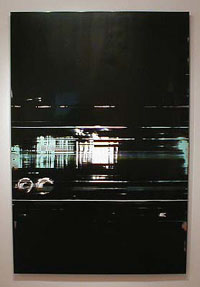
John Pomara, On Line, 2000
oil enamel on aluminum, 72 x 48 inches
This new variable suggests fresh content: the "impersonality" and "affectlessness" of the times, yes, but also a reference to the new visual landscape given to us by technology — "intermittent, static-laden signals on the information superhighway," as Davenport nicely puts it. There are plenty of interesting artists working in this territory: Stephen Ellis, John Zinsser, Bill Komoski, Shirley Kaneda, Mark Sheinkman, William Wood, Carl Fudge, Rochelle Feinstein, to name a few. Instead of the somewhat belittling "squeegee school," a better term would be mediated abstraction, referring to media in both the material and communications sense. This is an international tendency among painters, which both Pomara and Griffin are aware of and plugged into. And which, I might add, Pomara continues to work and evolve in. If we must compare Pomara and Griffin, a better job could be done. "Griffin is a man imitating a machine," Davenport says, while Pomara is "a painter using mechanical techniques to depersonalize his pictures." Isn't that a distinction without a difference? I'd say Pomara, with his succulent surfaces and all-too-human imperfections, is a man imitating a machine, while Griffin, with his high-polished control of every millimeter of a picture, is more like a machine imitating a man. (And I mean that in a good way.) - Tom Moody, New York
My reply has been edited slightly for punctuation and syntax. Some newer work by Pomara is referenced here. Earlier posts on him are here and here. With five and a half years' hindsight, I'd say that almost none of the painters mentioned in my reply represents much of a viable school any longer, except Pomara, who is busy morphing it into something else. Those *were* artists imitating machines, or a machine look, and little besides--that was probably not a good phrase to apply to him, because he's actually thinking below the surface of the computer, using processes of creative decomposition with imaging software to develop a new "pixelesque" iconography. His work belongs in the new media dialogue--painting is just a part of it.
Commodity fantasy:

Purely hypothetically, this Samsung .mp3 player could be loaded with the 190-some songs I have produced in the last two years, turning it into a kind of artist music box. Owners could delete the songs they don't like, or just use the player for as much other material as they wanted to add to it. This would save me having to issue multiple CDs, or prioritize my work when I may not be the best judge of my own prolific output. Send me $200 plus S&H and the 2GB Moody Music Box is yours.
Some recent paintings by John Pomara:



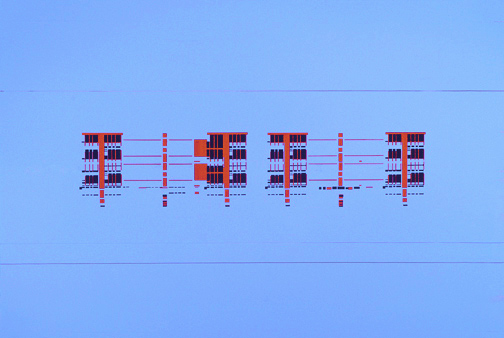


Titles are, top to bottom, Luv Connection, Corporate File, Digital Dating, Double Dating, Jailhouse Rock, and Jetsons (all oil enamel on aluminum). Earlier posts on Pomara's work, expaining a bit about the process are here and here. The current, stylish group handles digital content in a thoughtful, oblique way. These appear to have architectural subjects, but it's wholly invented or aleatoric architecture--emerging out of the process of deforming imagery at the pixel level. What look like "wrecked scans" a la Karl Klomp's "glitch video" work are just a starting point--the logic of messy revision and chance is continued into the painting realm, which is already very much about significant accidents, since the AbEx days. Pomara also makes photos and ink jet works in this vein, and there is much back and forth among media in his studio process.
Update: Some links to writing on Pomara in Houston's GlassTire online magazine weren't working in my April 2001 post but those pieces have now been located: Bill Davenport's review and my reply. The reply is unfortunately captioned "Responses to Tire Iron #6 by Jeff Dalton" but my name is in there somewhere.
Update: The text of Davenport's review and my reply are here.
Update, May 5, 2009: Those links were broken again. I'm linking to the barely formatted "print" pages as there is no way to permalink the articles. Get it together, Glasstire! Oh well, at least the writing hasn't disappeared completely. Rather amazing after 8 years on the web.
I've been making screenshots of my OptiDisc GIF when it appears as as a background image or avatar on MySpace, LiveJournal, or other blogs or message boards. Not because I care about the hotlinking (which is how I find it--any use of the bandwidth of the image shows up in stats--the hit is pretty minimal) but as kind of a sociological project. As in, how many different contexts is this artwork applicable in? Besides homepages, it seems to be very popular as an avatar on automobile forums (!). About a third of the time there is some caption like "Your eyes are getting heavy..." I have over 30 uses of the GIF preserved, from around the Net--unfortunately the screen grabs are only stills and don't show it in its full pulsating glory. Eventually I'll put them up on a separate blog page. The sameness-in-diversity aspect is pretty intriguing. (Or diversity-in-sameness?) Not all of them are as good as Da Kid's:
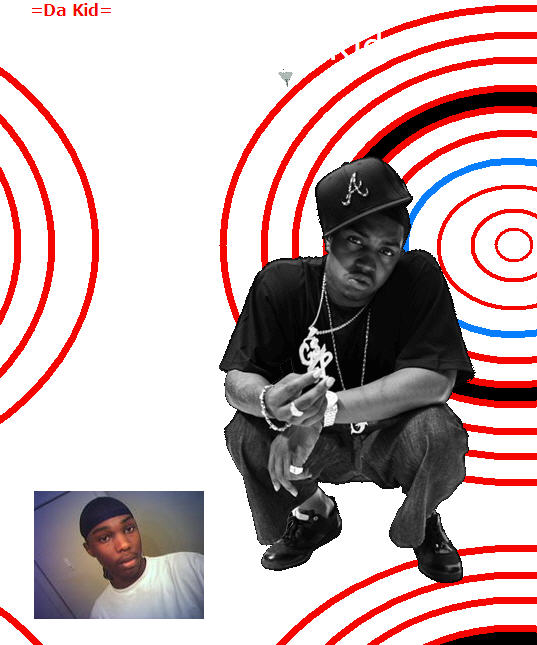
"Aruba '85 (Screwed)" [mp3 removed]
I suppose this could be called wormhole ambient electro lounge. I am adding percussion to this track and otherwise recuperating it from being a mere slowed-down song, so this is work in process. The Mutated snares sound like whipcracks at this speed--and there are other interesting sounds I hadn't considered.
I have been spending the past few days trying to "master" some recent songs. Basically just get'em up near CD volume. I am very leery of ruining songs with EQ that took a long time to mix, but I'm getting more confident. Yesterday I even learned how to create an "automated parameter" that gently rolled off the bass on a track that started out too "thin" but got louder at the bottom. It was kind of a thrill to watch that EQ curve moving as if by itself in real time. [/music diary]
Update: Added the percussion and chopped about a minute out of it. It's "dubbier" now.

Artist unknown, found here.
From Mideast scholar and blogger Juan Cole:
I see a lot of pundits and politicians saying that Sunnis and Shiites in Iraq have been fighting for a millennium. We need better history than that. The Shiite tribes of the south probably only converted to Shiism in the past 200 years. And, Sunni-Shiite riots per se were rare in 20th century Iraq. Sunnis and Shiites cooperated in the 1920 rebellion against the British. If you read the newspapers in the 1950s and 1960s, you don't see anything about Sunni-Shiite riots. There were peasant/landlord struggles or communists versus Baathists. The kind of sectarian fighting we're seeing now in Iraq is new in its scale and ferocity, and it was the Americans who unleashed it.Way to go, us! Saddam probably gets some credit for suppressing Shiites while his fellow Sunnis got fat government jobs. But there's no question who let the cork out of the bottle and then stood there clueless watching the explosion.
From the blog vault: "Show Us Your Gnomes."
"Blip Festival Cell Phone Call" [690 KB .mp3] (about 30 seconds)
Artist and artMovingProjects gallerist Aron Namenwirth called me on his cell phone while he was attending the recent Blip Festival of 8-bit music in NY; I was w*rking and missed the call, but I kept his phone message and made it into an .mp3. This is what the recorder picked up--it conveys a little of what you missed if you didn't catch the Festival.
Sitepal TM avatars (or rather "personal virtual characters"). The idea is that reading a blog is too tiring and we need a little cartoon character that looks sort of like the blogger to read the text to us in a synthetic voice. The reviews:
72 neutral-to-favorable del.icio.us links (with one or two hints of mild sarcasm)
vs
1 solid "creepy" from Guthrie Lonergan
Elsewhere Lonergan weighs in on the fake 3-D version of the Sitepal avatar: "wait till she talks twice and then she watches your cursor...creepsville." It's a fact--her eyes look like frozen horror movie eyes swiveling around inside a fright mask.
DJ Spooky said of the Net, back when it had a mystique: "the Net mirrors the street; as above, so below." This is still true, if by street we mean "place of rampant herd-like conformity." Case in point: 72 people accepting these goofy-ass personal avatars at face value, no pun intended, vs one person willing to suggest that the gimmick is flat-out macabre. (And that therefore, by implication, the creators should go back to the drawing board because they FAILED.)
From "Maya in the Thunderdome," by Marcello A. Canuto, about the inaccuracies in Mad Mel's Mayan movie (Salon, prob. subscription only):
In an action scene that springs entirely from Gibson's imagination, our [Mayan peasant] hero is able to escape the city. [...]. He flees through the jungle, and with only two pursuers remaining, he bursts out of the forest onto a beach. There, where the land ends and the water begins, both he and his tormentors witness Spanish galleons and rowboats ferrying Spaniards and Christianity to the lands of the Maya. His pursuers, as if in a trance, walk weakly toward the arriving Spaniards. Their pursuit is now irrelevant, as their world is about to end.
Again, the historical facts tell a different and more compelling story. Several accounts exist of Spanish expeditions in the early 1500s, sailing from Cuba and making stops along the Yucatan coast for provisions. Invariably these encounters ended badly for the Spaniards. So fierce was the Maya defense of their lands that Cortes avoided much of this coast, choosing to land farther west along what is known today as the coast of Veracruz. The Maya, at the time of the conquest, were intractable and fiercely autonomous. Most villages resisted the Spaniards. In fact, the Spanish conquest of the Maya was a long protracted campaign that some claim goes on to this very day.
In Apocalypto, the arrival of the Spanish signals "a new beginning." Remarkably, the event is portrayed as tranquil, as if the Spaniards are the adults who have finally come to rescue the "littleuns" stranded on the island of William Golding's Lord of the Flies. In reality, the arrival was anything but serene.
Within decades of the first contact with the Spaniards, the Maya would die in the hundreds of thousands as European diseases, colonial exploitation and cruelty took root. In 1552, in the name of Christian piety, Fray Diego de Landa ordered that hundreds of Maya codices, carrying sacred knowledge accumulated over centuries, be burned as works of the devil. If there were ever an apocalypse in the history of the Maya -- and herein lies the ultimate demoralizing irony of the movie -- it would be because of European contact. But in the movie, after two hours of excess, hyperbole and hysteria, the Spaniards represent the arrival of sanity to the Maya world. The tacit paternalism is devastating.
After many centuries of misguided and simplistic views of the Maya, recent scholarship has shown the complexity and historical depth of their civilization. In Maya society, as in all civilizations, violence, surfeit and disparity were balanced by accomplishment, restraint and illumination. Gibson's feverish vision of a childish Maya society sacrificing itself to extinction is more than inaccurate, it works against the progress of decades of diligent scholarship to restore to present-day Maya people a heritage of which they are proud, and from which we have much to learn. I can only hope that audiences seeing this movie will be motivated to learn about the Maya -- present and past -- rather than be sated by Gibson's sacrificial offering at the altar of entertainment.

John Parker, solo performance on the Elektron Monomachine, at the vertexList benefit last night. His gig combined live improvisation with programmed sequences built up in the studio note by note. Manufactured by Swedish hacker types, the Monomachine is a sophisticated descendant of the old 8-bit chips (Elektron also made the Sidstation, using a Commodore 64 chip) and has a nasty edge of pure DSP (digital signal processing), which may explain Parker's popularity with the 8-Bit crowd in attendance last night. Also, his penchant for unexpected dark metal riffs popping up out of the sometimes atonal chaos of live sequencing and knob turning didn't hurt.
The Reeler has a report on the Digital Art and Video fair (DiVa) at Miami, penned by Paddy Johnson, who covered all the Miami events this year on her blog. She concludes that
...by and large the ratio of good stuff to crap was much better than that of other fairs. Still, how good can a fair possibly be if nobody knows about it? I met some of the most fascinating artists I had seen in a long time, and I feel like I was one of maybe 20 people who noticed. The odds of something like this occurring during a time where there are 1,400 journalists in the city covering the art seem wholly unquantifiable. In the end, it may also serve well as the most compelling evidence that cinema and digital art are of little importance not only to fair organizers, but also to those who attend and report on them.Among the reasons cited for the lack of traffic at this fair (which I had work in) were bad weather, remoteness from the main fair locales, and underpromotion via flyers, etc. But as Johnson suggests, the chief explanation is that "Miami" is about selling objects, not experiences. After a couple of decades in which conceptual art, performance art and video made inroads into the art marketing system, we are in a period of conservative retrenchment, greased by "Bush millionaire money" in the hands of undiscriminating collectors, where almost any bad thing flies off the wall as long as it has physical presence and the perception (usually wrong) that it can be easily unloaded later.
Ironically, or as if reflecting some perverse inverse ratio, this tulip mania for painting and sculpture is occurring just as a new art model--one that is neither performance, conceptual, or video, but was reflected in some measure in the DiVa fair--is on the rise: I refer to art made with home computers, as well as (or overlapping with) art being made on and about the Internet. That's where the intellectual juice is now, not the nth repetition of neo-expressionist painting.
In case you were wondering what Daniel Mendelsohn looks like, here he is. Who is Daniel Mendelsohn? He's the writer who so burns with jealousy over Jonathan Franzen's success that he wrote a memorably hateful hatchet job on him in the New York Times. Several people I talked to, including ones who'd never read Franzen, read that piece and were appalled by how harsh and personal it was. (Also badly written.) Mendelsohn is the subject of a lengthy interview on Salon today, discussing his just-released, "Proustian" book about the Holocaust. Yes, that's how it's described. We already know everything we need to know about Mendelsohn, though, from his Franzen review, and that publicity photo, which I think you will agree is very...smooth. Oh, and one more detail--he lives in an upper West side apartment that Salon describes as "elegantly furnished."
Some funny responses to the photo from the comments, after the jump.
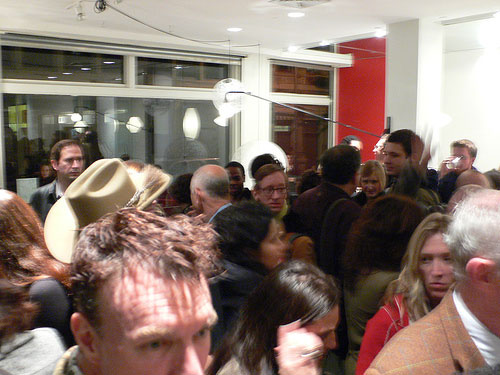
Party with Design*Sponge and the other design bloggers! (Everyone in this picture looks miserable.) From Curbed.
vertexList gallery is having a benefit raffle tonight: photos of the donated artwork are posted on its blog. The event lasts from 7-10 pm; raffle starts at 8.30 pm; tickets are $200--details here. jenghizkhan (aka John Parker) will perform a couple of new music pieces live at 7:30 pm; other attractions include limited edition t-shirts by Eteam, limited edition pins by Sakurako Shimizu and a sign-up sheet to reserve a copy of vertexChips, a compilation CD in a micro-edition of 50 that will be released next week, featuring Covox, Bubblyfish, Role Model, Herbert Weixelbaum, Receptors, Bit Shifter, jengizkhan, Nullsleep, Treewave, David Kristian, Glomag, Huoratron, and yours truly.
Be there, aloha. It would be nice if New York landlords would support the art community here but that's not what they do--they raise rent so they can live like Lords and say FU to the rest of us!
Updated with new info about the CD.
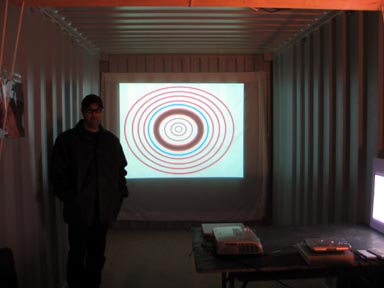
Aron Namenwirth of artMovingProjects, in the gallery's shipping container at the DiVa (Digital and Video Art) Fair this year in Miami. In the background is my DVD OptiDisc.
Update: The photo above is by Paddy Johnson, using Namenwirth's camera. Aron has posted more photos here.
"Hacker Fashion" [mp3 removed]
A kind of ongoing duet between a "warm, fluid" analog synth and a "cold, brittle" digital synth, mirrored underneath by the allotment of analog percussion to one channel and sampled digital beats to the other. I'm interested in similar oppositions and symmetries in visual art--a balance of "grains" and their accompanying "philosophies." Not to mention the binary use of scare quotes.
Update: I dropped the digital synth parts a semitone, muted some high notes, and raised the filter cutoff frequency so those parts are a tad more mellifluous.

Large Mill, 1995, acrylic, gouache, ink, and pencil on paper, 90" X 88" (Stage One)
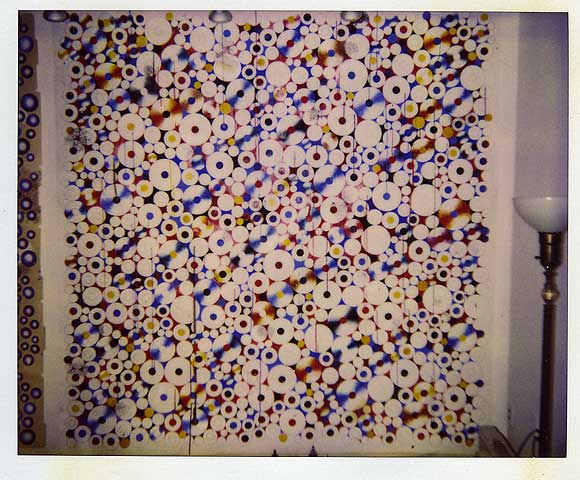
Stage Two
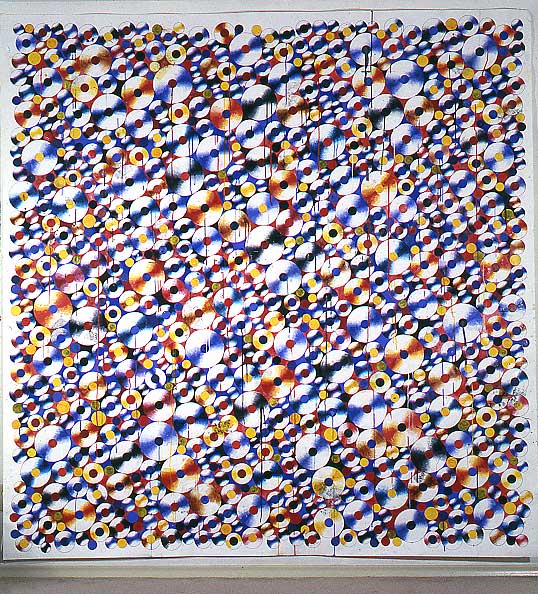
Final Version
never exhibited--done right before I moved to NY and started working with a computer. the piece got more difficult to look at as it was completed--by the end it was impossible for very long without retinal strain and headaches--the early stages appear tasteful in the polaroid scans but the colors are pretty artificial and obnoxious in person--I contemplated stopping the process and calling it done at many stages but pressed on out of some innate sense of responsibility to the initial premise. the "disc" design was originally based on paintings of rolled-up silk seen end-on in a Russian constructivist-influenced painting, I think by Liubov Popova.
The vertexList blog has a report on the DiVa (Digital Art and Video) art fair in Miami and some pictures of the shipping container on the beach where my and some other New Yorkers' work was showing. One gathers from that blog and Paddy Johnson's that the event was...underpromoted. Fairs suck, and a few posts back I offered showing in a shipping container as one of the few things helping to prop up my self-image as an aloof avant gardist. A reader then jumped in and proceeded to demolish the very idea of showing in a container in a couple of unstinting, scorched earth comments. These went a long way towards knocking out my last strut of personal dignity. Seeing the vertexList pictures helped revive it, though--in that the images of the white metal boxes on the sand with palm trees in the background seemed kind of romantic to me. As I said in that comment thread, I am proud to have shown in Miami and appreciate my shot at the big time.

93 kilobytes of RAM (ha ha).
This is an excerpt from a Dec. 5 Salon piece by Cintra Wilson on presidential hopeful Rudy Giuliani. Steve Gilliard has more of it, and discusses in detail Giuliani's penchant for publicly abusing his "loved ones":
There is something deranged about you ... this excessive concern with little weasels is a sickness ... you should go consult a psychologist or a psychiatrist with this excessive concern, how you are devoting your life to weasels. You need somebody to help you. There are people in this city and in this world that need a lot of help. Something has gone wrong with you.
-- New York Mayor Rudolph Giuliani on his radio show, to a ferret advocate, after imposing New York's 2001 ferret ban
The attack on the twin towers blew a hole in downtown Manhattan and in our collective memory. Osama bin Laden and company did a better P.R. job for Giuliani than spin ghouls Hill & Knowlton ever did for Dick Nixon. He made everyone but the most grouchy and resentful New Yorkers [like me --tm] forget that before planes crashed into the World Trade Center, Rudy was a hyper-authoritarian narcissist with a lust for overkill verging on the sociopathic.
And now, at a time when the machinations of another hubristic bully have brought an unprecedented expansion of the powers of the presidency, "America's Mayor" may be our next chief executive. He is neck and neck with John McCain when Americans are asked their preference for the next occupant of 1600 Pennsylvania Avenue. It is alarming to think that the murky dealings and totalitarian tendencies that have marred the current administration could flourish even more under another control-junkie Republican. It is even more frightening to think what a commander in chief who already has a violent record of abusing authority could do with the unrestrained might of a geopolitical superpower. Given Giuliani's historic willingness to take Spanish Inquisition-style action against threats both real and imaginary, is anyone in doubt that it is every American's duty to keep Rudolph Giuliani as far from the White House as possible?
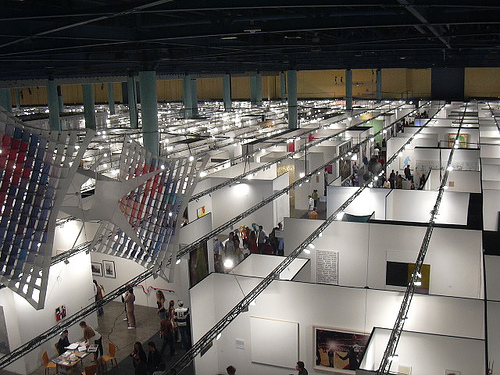 Photo by Paddy Johnson of the inside of a Borg cube--I mean, Art Basel Miami. This is where artists are assimilated, er, discovered. Their difference adds to the perfection of the Hive Mind, that is, "provides a spiritual lift to the buyer for cash." In any case, resistance is futile. (You gotta love the irony--the owner class extracts capital from cube farm labor, then seeks personal fullfillment and the pressure release of excess money buildup through art purchases...in a cube farm.) |
"Mathematical Eyes": numinous, too-somber-to-be-camp new music and vid from Black Replica and Heinrich Mueller (aka Arpanet, Dopplereffekt, etc) [YouTube]. Cocteau meets David Lynch for an afternoon LARP (just covering my ass here for the naysayers). The intermesh of the music and moving images dazzles, and the shots with the alien child both move and chill. 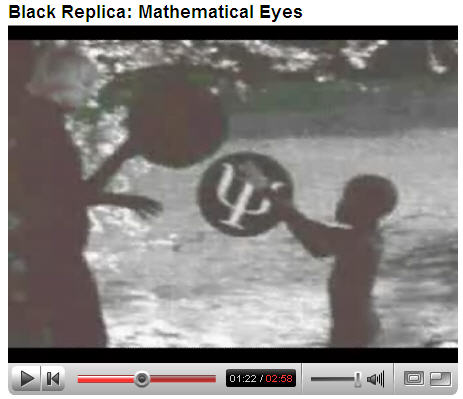 The Black Replica MySpace page, with some more songs, is here. Via Drexciya Research Lab, a great blog, website, and MySpace page concerning all things James Stinson (r.i.p.) and Gerald Donald. (Detroit electro musicians as important as Coltrane and Sun Ra, if listeners can "take their minds to another level," to quote a Drexciya song, probably a collaboration betw. the two artists) |
"Ionic Baroque (Dance Mix)" [5.9 MB .mp3]
A recently posted song revised and extended. A beat comes up in the middle where there used to be a-rhythmic semi-collapse and establishes what can only, fairly, be called a "groove," lasting from about 2/3 of the way through to the end. I'm fairly happy with the production and overall sound balance of this track. It's a nerdy piece, probably not too popular, but I plan to do more of them.
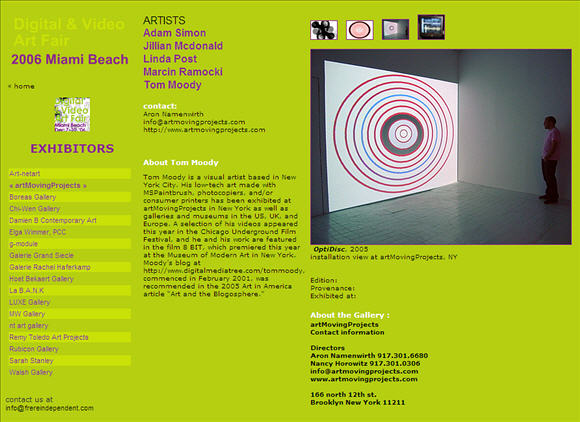
Someone assumed from a previous post that because I had work at the Digital Art and Video Fair (see above) that I was going to Miami. I AM NOT GOING TO MIAMI. It's bad enough having to see work by artists like Takashi Murakami in NY, much less having to travel to see it.
But, um, I certainly appreciate artMovingProjects taking my work down there so I can stay here in my ivory tower. The DiVa fair is being held in shipping containers on the beach, so a certain aesthetic distance is maintained from the general orgy of commerce. As befits the true vanguard.
1986
"It's My Beat" (Sweet Tee and Jazzy Joyce)
Jazzy Joyce (On the wheels) Jazzy Joyce (No one better)
Jazzy Joyce (Speedin' faster than an '86 Jetta)
Cold blooded terrorizin', baby, that you can bet
(And if you battle me, never let me see you sweat)
Hear it: 250 KB .mp3
1994
"9th Wonder (Blackitolism)" (Digable Planets with Jazzy Joyce)
Jazzy Joyce (On the wheels) Jazzy Joyce (No one’s smoother)
Jazzy Joyce (Phatter than a '94 Land Cruiser)
Where you from? (The Bronx, representin' like whatever fly)
Cool, are you slicker this year? (Yeah, why?)
Hear it: 250 KB .mp3
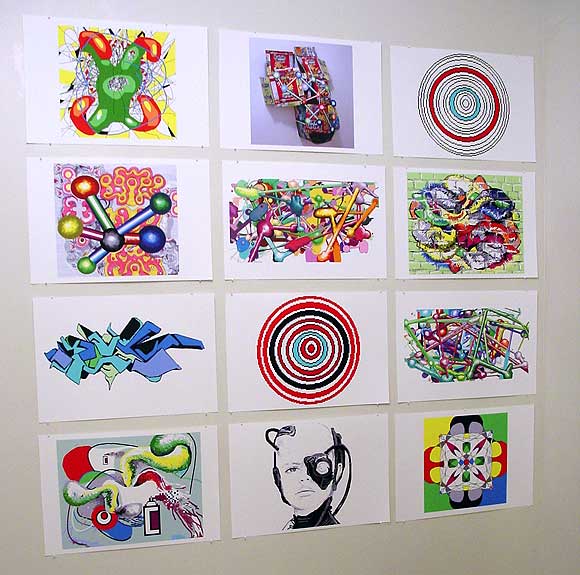
My criteria for this group of images were everything had to: (i) be printed landscape orientation, 13 x 19 inches, and (ii) have appeared on this blog since the printing of the last group of pictures done in this fashion. All are 100% rag paper, archival ink, blah blah. The grouping is at once an installation, twelve separate drawings (a term I'm stretching to include photography), a physical record of images disseminated online, and a reification of a particular slice of this blog. Some of the content I invented out of whole cloth; some are my interpretations of others' images. Except for changes in scale to fit the paper size, nothing was altered from the way it appeared online. These would be framed for a real-space presentation. Sorry if this sounds stuffy, just trying to nail down my concept.
Spoken word mp3: Interview with Marcin Ramocki and Justin Strawhand about the movie 8 BIT - about 35 minutes long - can be found on the Small World Podcast blog. Begins with a Bill O'Reilly soundbite about evil, pathetic kids "plugged into machines" and proceeds to rebut that nonsense. A good, tuneful Bit Shifter Game Boy music piece at the very end.
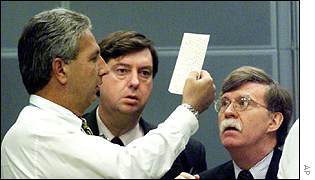
John Bolton is resigning after pretending to be UN ambassador for a year--finally! As the photo above reminds us, he was one of the recount cheaters who got Bush "elected" back in 2000. (See those fanatic eyes searching, searching for hanging chads.) He's a Bush loyalist, a hard core right winger, a hack--he should never be in the UN because his kind wants to abolish it.
Good Simon Reynolds post on "the future" in music:
Perhaps there’s a three-way division here.As for "futuroid," the only way you could really evaluate something "unforeheard" would be after it already occurred, so this category is paradoxical and possibly useless for present criticism or music creation. But the 3-way definition is a good way of getting at the differences between what's actually happening that's forward-looking, unexamined retro notions (a la The Jetsons) of what's ahead, and the undefinable something that the future will recognize as avant garde or "ahead of its time." I agree with the statement in his post that early '90s breakbeat hardcore was more revolutionary than what came after, drum and basswise, yet was about musicians trying to top each other with new gear "in the now"--not with some eye cocked on the future.
Futurism
Artists who make an overt ideology out of their aspiration to make tomorrow’s music today (this would include quite a few techno people, but also a group like The Young Gods, or earlier, the Art of Noise--both of whom could also be seen as having a relationship to the actual early 20th Century movement Futurism, adding a tinge of retro-Futurism)
Futuristic
Artists who play with science fiction imagery, a set of signifiers and associations that refer back to a tradition of how the Future was envisaged or sonically imagined. For quite some time--even in the early 90s--this kind of thing already had a retro-futurist tinge to it. Again lots of techno artists went in for this kind of imagery but so did a lot of genres (synthpop, industrial, space music) outside the dance field.
Futuroid
The actually emergent or unforeheard elements in music.
(Why not call this 'modernist'? Well, Modernism is itself a style, a period-bound thing to the point where there is such a thing as retro-modernism... Not all futuroid things are going to manifest as stark/lacking ornament/bleak/brutal/abstract/functional/minimalist, i.e. the cliches of modernism... For instance breakbeat science as it evolved turned into a kind of rhythmic baroque, and wildstyle graffiti, while futuroid and futuristic, was not Modernist in that style-defined sense of stark etc).
To map this onto the old Raymond Williams residual/emergent dichotomy, most musics that are any good or at all enjoyable or have any impact on the wider culture are going to involve a mixture of futuroid and traditional. A wholly Futuroid music would probably be as indigestible as Marinetti’s proposed Italo-Futurist replacement for pasta--a dish of perfumed sand.


Gore Vidal on Film; Javier Morales and John Michael Boling's "The Church of the Future"
From an interview with Gore Vidal in this month's Bookforum:
BF: Your writing career extends to the silver screen, particularly your script for Ben-Hur. You wove in a homoerotic story line that suggested a past romance between Ben-Hur and Messala, but this fact was supposed to be kept secret from Charlton Heston. Was there a thrill in doing that?What Vidal says about film--it's the only art form that "lacks mind"--and the default role of editors in creating that art is a slap at auteur theory but I agree with him in the sense that film is more like painting or music than literature. I thought about his comment when I saw this web video by Javier Morales and John Michael Boling called "The Church of the Future," which assembles a story out of pure televisual vapor. It has no more or less "mind," in the sense of a cognizable rhetorical point, than the Nightly News does--another kind of "film," which we take to be real, but which is a crafted amalgam of clips that may convey messages different than what the producers intended. Yet the "Church" video is profound, in the way its editing choices create a mood of tension and weirdness out of sampled mainstream TV (only the Marilyn Monroe mask wearing businessman--which seems very DEVO/Subgenius/Firesign Theatre--departs from "ordinary."). Some of the big hair reaction shots from a random "televangelical" audience are exquisite portrait photographs.
GV: No, it was necessity. The script just didn't work. I had to explain why on earth they're feuding for four hours. The romantic subtext worked like a dream.
BF: Charlton Heston, of whom you wrote directing him must be like trying "to animate an entire lumberyard," refused to acknowledge your contributions to the script, insisting that the director, William Wyler, rejected your suggestions.
GV: Charlton Heston told lies. I had as little to do with him as possible. He was also the last choice of the director and the producer. They were stuck with him. And then it turned out he wasn't as good as Stephen Boyd, who played the Roman. But that was not my problem. I was not producing it. I was there to try to dramatize an old and rather junky story.
BF: In the new memoir, you say that, in today's culture, "where literature was movies are." Are there films that rank with good literary fiction?
GV: I don't think you could ever compare the two. Literature is where it is and totally different, and movies are a peculiar art form. Film is the only art form that lacks mind, because there's no way the individual writer can supply it with ideas. Directors make their contributions, some better than others. Film editors probably do the most work toward creating what you see up on the screen. And they are working quite separately from whatever the movie may be about. They're just trying to get images straight. It's not a medium you can invest with the sort of ideas that work in a novel or even poetry.
Update: scare quotes added to the word televangelical since we have no idea who this audience is. See comments.
Two early '30s Frank Capra movies on TCM last night I'd not seen--American Madness and the better-known Lady for a Day. The former prefigures It's a Wonderful Life with its honest banker (played by the dynamic Walter Huston) who makes loans based on his personal assessment of a borrower's character, as well as a scary "run on the bank" scene where Huston makes a speech to panicked depositors. An amazing montage of faces and voices showing how the rumor spreads leading to the run (marred by a couple of '30s-obligatory but obnoxious racial caricatures) is insanely fast paced and instills a sense of stomach-churning helplessness in the viewer at not being able to stop this human folly. Regarding the speed of the film generally, Capra's IMDb bio offers this intriguing stylistic analysis:
Capra had become convinced that the mass-experience of watching a motion picture with an audience had the psychological effect in individual audience members of slowing down the pace of a film. A film that during shooting and then when viewed on a movieola editing device and on a small screen in a screening room among a few professionals that had seemed normally paced became sluggish when projected on the big screen. While this could have been the result of the projection process blowing up the actors to such large proportions, Capra ultimately believed it was the effect of mass psychology affecting crowds since he also noticed this "slowing down" phenomenon at ball games and at political conventions. Since American Madness dealt with crowds, he feared that the effect would be magnified.
He decided to boost the pace of the film, during the shooting. He did away with characters' entrances and exits that were a common part of cinematic "grammar" in the early 1930s, a survival of the "photoplays" days. Instead, he "jumped" characters in and out of scenes, and jettisoned the dissolves that were also part of cinematic grammar that typically ended scenes and indicated changes in time or locale so as not to make cutting between scenes seem choppy to the audience. Dialogue was deliberately overlapped, a radical innovation in the early talkies, when actors were instructed to let the other actor finish his or her lines completely before taking up their cue and beginning their own lines, in order to facilitate the editing of the sound-track. What he felt was his greatest innovation was to boost the pacing of the acting in the film by a third by making a scene that would normally play in one minute take only 40 seconds.
When all these innovations were combined in his final cut, it made the movie seemed normally paced on the big screen, though while shooting individual scenes, the pacing had seemed exaggerated. It also gave the film a sense of urgency that befitted the subject of a financial panic and a run on a bank. More importantly, it "kept audience attention riveted to the screen," as he said in his autobiography. Except for "mood pieces," Capra subsequently used these techniques in all his films, and he was amused by critics who commented on the "naturalness" of his direction.
More dubious fractal analysis of Pollocks and digs at that goldang modern art from Randy Kennedy of teh NY Times.
two researchers conclude that Dr. Taylor’s analysis of Pollock paintings is flawed because it did not use a great enough range of box sizes to establish fractal characteristics reliably. Using only the range he did, a childlike drawing like the one made by Ms. Smith-Jones turned out to be, mathematically at least, the equal of a Pollock — a notion that would undoubtedly amuse critics who still dismiss his work as child’s play.Since when is Rush Limbaugh's opinion relevant?
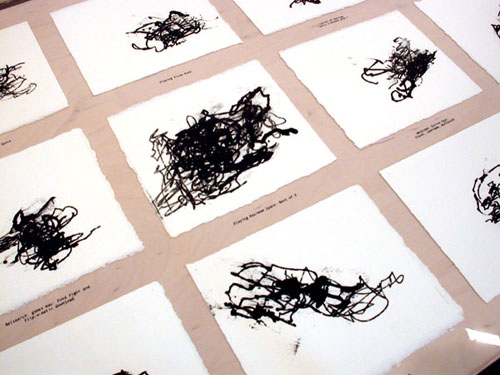
A previous post dealt with several incarnations of the "mousepad drawing"--by Kristin Lucas (1999--photo above), the Eyebeam Open Lab (2006), and Joseph DeLappe (1999-2002). To recap, Lucas inked a mouseball and let it make drawings while she played games, answered email, etc.; the Eyebeam project is a recently-invented "double mouse" that allows anyone to make abstract marks on one screen while doing routine things on another; and the DeLappe is a mouse with various physical pencil and brush extensions that also make mock-gestural drawings. I can't really compare the drawings because I've only seen the Lucas firsthand (they were nice, with an organic Cy Twombly-ish feel belied by the banal origins). However, I'm intrigued by her expressed intentions behind the work in a way I'm not with the other projects. The presence or absence of an underlying rationale goes a long way towards defining whether something is art in the humanist, Western Civ tradition or just an extension of tech practice. Here's what Lucas says about her series:
"At the time, I was making work about the influence of programmed environments on my behaviorial patterns (mental and physical). So [in the case of the mousepad drawings] an influence of the virtual recorded in the physical realm. I found the inked mouse drawings looked psychological--their motion cramped, frustrated, oscillating between resisting control by external forces and controlling oneself (like being trapped in an argument with oneself). My drawings are never shown with the tool so they are more about the discovery of what they are and enjoying the irony or sincerity of what the task was. Also factoring in was the scale of a world wide experience reduced to a tiny sheet of paper.By contrast, DeLappe (photos immediately below) seems to be making a broad critique of the pseudoscientific forebears (or cousins) of modern art such as graphology, Freudian analysis, and/or mediumistic "automatic writing" (one supposes--the statements I found on his website don't really explain why he is doing it) by presenting entire suites of work each of which is supposedly influenced by a specific activity such as preparing income taxes, or surfing Museum websites. These sources of anti-inspiration or non-inspiration are exhaustively detailed in the finished display, down to noting the URLs and characteristic colors of art world sites. Unlike Lucas, he presents the mouse as a sculptural object related to the drawings and even lists the brand of the mouse in the description.

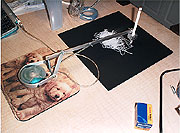
By the time we get to the Eyebeam Open Lab's "9 to 5 Paintings," the idea has been mainstreamed and popularized down to the level of an executive toy, with breezy description to match:
Create art while you work! If you find yourself spending more and more time answering email, and less and less time making art then why not do them both at the same time? Turn your emails, internet browsing, and report writing into digital paintings. 9 to 5 paintings are a visual representation of your daily computing routines.
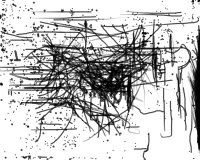
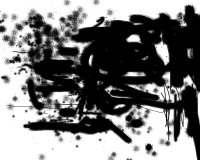
Here it's mainly about the gear, and BAW (bored at work) fun. The introspection and societal critique of Lucas' project has been decanted away, leaving only the absurdity.
Related: techy takes on Pollock.
"ElectroYacht" [mp3 removed]
Digital percussion kit crafted with a Sherman filterbank (originally by Speedy J with some changes by me), with an analog break (played twice) on the Mutated Sidstation--a kind of tuned drum setting played at different pitches using midi cc (continuous controller) messages. Unlike the previous track, which I spent way more time on, this has a nice relaxed vibe.
"Ionic Baroque" [mp3 removed]
In this song I've grafted together layered nasal synthesizer melodies with orchestral instruments such as strings, marimba and tympani. I had the idea to do, as I described to someone in an email, "baroque chamber music using dismantled electronic dance elements." This is a stab at that. The piece is tightly organized at the beginning, breaks down about 2/3 of the way through, and never completely recovers--that is deliberate.
Just realized I started posting music on my "mostly music" blog two years ago this month (and cross-posted most of it here). Unbelievable--time flies, etc.
Update: am working on a longer, "dance" version of this tune. Instead of the "breakdown" described above, a house thump fades up and rescues the momentum of the song, carrying it well beyond the current end. With the four-on-the-floor rhythm underneath, the strings have a "hooked on classics" feel.
And here it is:
"Ionic Baroque (Dance Mix)" [mp3 removed]
Excellent '70s strangeness: two songs by the Boston-based Orchestra Luna, who released one record of eccentric showtune-influenced music on Epic and then were dropped by the label. Produced by Rupert Holmes of "Pina Colada" fame, and it shows. Nevertheless, it's not a big stretch from this music to the Bonzo Dog Band or Slapp Happy. I thought I was a cult of one; thank god for the internet. The sound files below are from the website of Rick Berlin, who recorded under his given name Rick Kinscherf on the Orchestra Luna LP.
"Boy Scout Camp" [2.8 MB .mp3]
"Little Sam" [3.8 .mp3]
